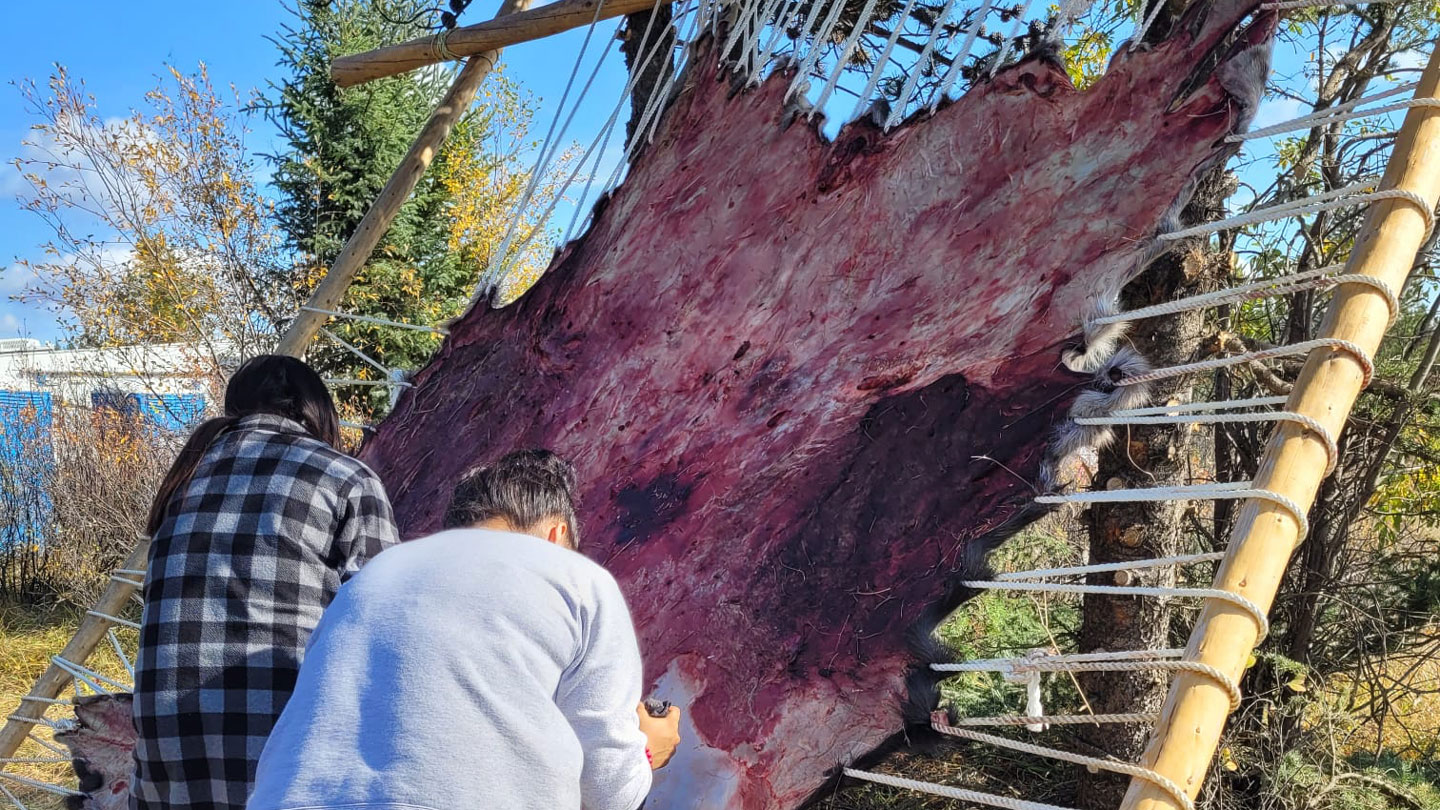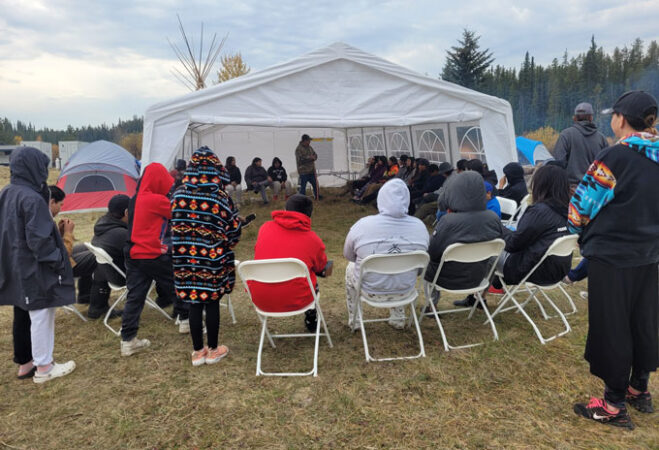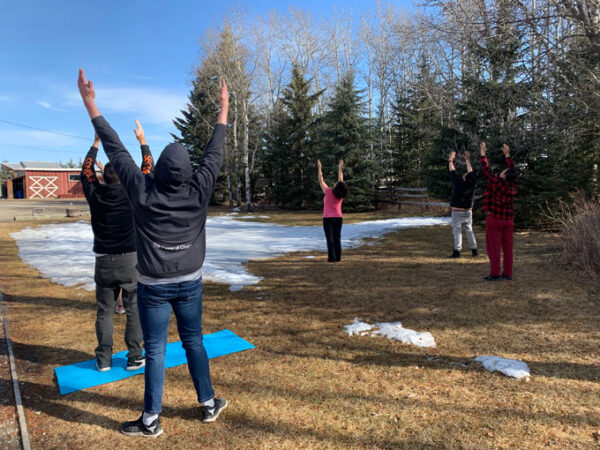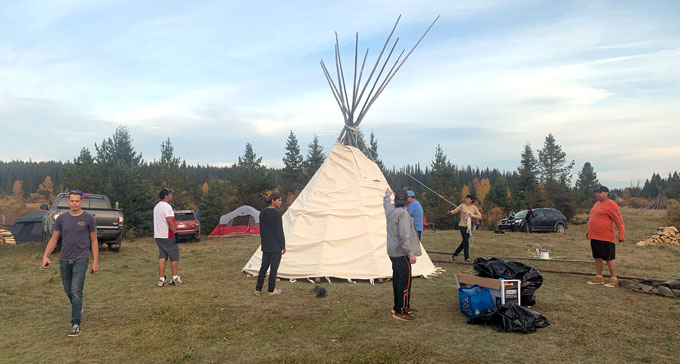An apology to Indigenous communities sparks a mental health rethink

Earlier this year, the leading psychological association in the United States apologized to the country’s Indigenous people and communities for directly and indirectly supporting centuries of abusive assimilation efforts. Those efforts included pushing Indigenous people off their lands and separating children from their families for placement in boarding schools.
The harms of these practices to Indigenous communities are ongoing, the American Psychological Association acknowledged in a report released in February. For instance, culturally inappropriate mental health diagnoses and treatments have exacerbated Indigenous communities’ already disproportionately high rates of mental illness, chronic disease, incarceration and suicide.
By the numbers, American Indian and Alaska Natives report serious psychological distress 2.5 times as often as members of the general population. They are almost five times as likely to die of alcohol poisoning than the general population. And they have the highest rate of suicide of any minority group in the country.
The APA also pledged its commitment to learning about and valuing culturally appropriate approaches to care moving forward. “Psychologists working with Native clients should respect, honor, and include Native strategies for healing,” reads one bullet point. “Psychologists need to learn about research methodologies developed by and for Indigenous populations,” reads another. APA leaders also issued in-person apologies at the June annual meeting of the Society of Indian Psychologists in Logan, Utah, and again in August at the APA Convention in Washington, D.C.
This apology honors the longstanding, often underappreciated, efforts of Indigenous and other researchers working with Indigenous communities. In recent years, Canada and Australia have issued similar apologies to their countries’ Indigenous populations. Such apologies pave the way for the sort of deep changes in thinking and treatment that are needed to help Indigenous communities heal, researchers involved in this work say.
These researchers anchor healing in Indigenous world views that prioritize harmony between people and the planet. And they recognize the powerful role history plays in shaping health and well-being. Indigenous psychology is about “looking at the whole person — the mental, the physical, the spiritual, the emotional — within the context of colonization,” says Suzanne Stewart, a psychologist at the University of Toronto and member of the Yellowknife Dene First Nation in Canada.
Specifically, many Indigenous-centered treatments incorporate traditional practices, such as making crafts from local materials, collecting medicinal herbs and engaging in rituals. Underlying such programs is the idea that if the historical trauma of colonization is the problem, then cultural revitalization could be the solution.
This culture-as-treatment approach represents a marked departure from Western approaches to care, which often minimize historic and cultural context. Assessing the success of those methods is also difficult using measurements typical in Western medicine. So researchers working in Indigenous psychology are measuring the effectiveness of those programs through qualitative, culturally appropriate methods, such as detailed first-person accounts.
Apologies like the one from APA mark an important step forward, says psychologist Karlee Fellner of the University of Calgary in Canada, and a citizen of the Métis Nation of Alberta. But Feller wonders, can the scientific establishment accept such a radical departure from care and research as usual? “That’s the question mark.”
Using culture as treatment
Indigenous understandings of well-being have evolved over tens of thousands of years. These populations are not a monolith; they speak many languages and engage in myriad cultural practices.
But a golden thread running through their belief systems is the idea that well-being stems from a healthy relationship between people and their environs, says Patricia Dudgeon, a psychologist and researcher at the University of Western Australia in Perth, and a descendant of the Bardi people from the Kimberley. Those relationships include both human and nonhuman relationships, such as relationships with one’s ancestors, other animals and the land.
In the United States, the idea of restoring this golden thread, or returning to culture to facilitate healing, gained momentum during the Red Power Movement from roughly 1969 to 1979. Activists sought greater autonomy for Tribal nations to protect against further assimilation with white culture. They viewed such assimilation as a form of cultural erasure.
The idea of culture as treatment became so popular that people working in Indigenous communities assumed that the approach worked, says Harvard University psychologist Joseph P. Gone, a member of the Aaniiih-Gros Ventre tribal nation located in Montana. But the theory had gotten ahead of the science. Gone and others began to explore the idea more systematically. Those efforts have included formally defining what is meant by Indigenous psychologies, developing programs that adhere to those world views and identifying culturally appropriate ways to measure how well they work.

Dudgeon and coauthors recently outlined a definition of Indigenous flourishing they developed in conjunction with Aboriginal community members. That work, published in March in Nature Reviews Psychology, suggests that well-being for Indigenous people in Australia includes seven domains, all influenced by social, cultural and historical forces, as well as individual experiences and personality. Those domains include mind and emotion, body, family, community, culture, country and spirituality. “That [definition] looks at the whole of the person,” Dudgeon says.
That holistic view, in turn, shapes how researchers think about improving Indigenous people’s well-being. “Just looking at differences in world views, I think that Western healing is about empowering the individual to have control over their environment and so on. That is not really in keeping with Indigenous world views, where it’s about relationships,” says mental health clinician and researcher Rod McCormick of Thompson Rivers University in Kamloops, Canada. McCormick is a citizen of the Kanienkehaka (Mohawk) Nation.
For instance, over a decade ago, Gone partnered with the Blackfeet Nation in Montana to develop a summer cultural immersion program for people struggling with addiction. In 2012, Gone helped launch a 12-day pilot program for four participants, described in the 2015 Psychological Services. During camp, participants engaged in sweat lodge and pipe ceremonies, pitched tipis, procured and prepared food, harvested sacred plants and tanned hides.
The rationale behind using culture as treatment is multifaceted, Gone writes. Among them, this approach can restore Indigenous people’s connection to the places and practices — a source of purpose and meaning — that colonization eroded. It has the potential to provide people with a sense of spirituality that is incompatible with substance use. And it can help participants develop new social networks.
Participating in cultural activities helps participants use their cultural past to chart a new path forward and achieve a greater sense of purpose, Gone writes. “By virtue of their participation in camp activities … they were engaged in crafting functional contemporary identities and modes of living that were continuous with — rather than alienated from — that past.”
Other researchers have modified the concept of Western talk therapy for an Indigenous clientele. Indigenous Focusing Oriented Therapy starts with the idea that trauma in Indigenous communities is intergenerational and shaped by colonization, researchers report in the April The Counseling Psychologist. During a typical IFOT session, a therapist and client sit facing the land in front of them rather than across from each other to acknowledge the vital link between place and well-being. Moreover, rather than talk about their trauma, as in the Western therapy model, clients are encouraged to foster their “felt sense” — essentially using the body’s emotions, energies and sensations to express knowledge of how one is part of a larger web of human and nonhuman relationships.
“IFOT is applying a Western therapeutic tool,” says Fellner who is trained in the method. “But what really makes it different is that you are coming from Indigenous ways of understanding.”
In a presentation at last month’s Society of Indian Psychologists’ meeting, Fellner and her team described how they took the IFOT model out of the office and onto the land. The team held a 24-day pilot program at the base of the Rocky Mountains in Alberta, Canada. Six participants attended a combination of IFOT therapy sessions and land-based activities, such as making spirit dolls and medicines from local herbs.

“Taking IFOT to the land has proven a powerful approach, says Fellner, who continues to lead this work with communities. She recounts a healing circle she ran earlier this year. Several elders joined the group one day and shared traumatic stories of their pasts, such as experiencing the death of their adult children. “All of a sudden when we were done sharing, this wicked hailstorm came in and flooded the tipi. We ran into the nearest building when we had the opportunity. We were all drying off. The elders were all laughing,” Fellner recalls. “The land came and helped us.”
Questioning the gold standard
Rigorous trials of these sorts of cultural treatment programs remain rare. Reasons why include difficulties in securing funding, low participation rates and questions around the cultural appropriateness of using Western methodology to measure Indigenous psychology.
Gone, for instance, could not experimentally test the effectiveness of the Blackfeet cultural immersion program or another program he helped launch later in Detroit. “In neither instance did we proceed to get the kind of funding that would allow [us] to evaluate them,” he says. Gone attributes part of that funding difficulty to the conservatism of scientific health agencies that prioritize incremental changes to existing programs over wholly new approaches.
Researchers who do manage to run randomized controlled trials, the purported gold standard of scientific measurement, often find that cultural treatments don’t work as planned, Gone noted in May 2023 in the Annual Review of Clinical Psychology.
“Most of them found that culture didn’t matter or that in some cases, it led to potentially worse outcomes,” Gone says. But the results are “not big enough to really have confidence in the findings. So they’re suggesting that culture doesn’t matter or that in fact it’s harmful but without the proper controls to really have confidence in the findings. That’s bad.”
Recruiting Indigenous participants to such studies is incredibly challenging, McCormick says. “People don’t want to participate in experimental research much. We have got a bad history with research. Research has been done on us.”
Even when researchers manage to recruit enough participants, many drop out. For instance, in one of the six recent randomized trials Gone reviewed, only 30 percent of participants completed nine or more of the 13 therapy sessions.
The problems with clinical trials, though, are both logistic and cultural. Western psychology rests on certain norms, such as the belief that behavior can be broken down into discrete units and that individualize prioritize self-reliance and autonomy, the authors of the APA report note. “The assumptions made by American psychology are contradictory and reductionist compared to the complex, holistic and inter-relational view of health that has been integral to Indigenous people for thousands of years.”
That reductionist approach allows researchers to deliver the same treatment to one group and compare their outcomes to another group not receiving the treatment. But that way of thinking runs counter to Indigenous understandings of sickness and health.
The established diagnostic and treatment process, for instance, does not account for the historic and ongoing traumas associated with colonization, Stewart says. “Western psychology doesn’t really give reasons or causes of mental health disorders because the Western biomedical model is about remediating symptoms. You remediate the symptom, the disorder goes away.” Cultural revitalization practices, by contrast, are localized to given communities.
And diagnostic labels can amplify historic wrongs. “Diagnoses have energy, they have spirit, they manifest. To diagnose somebody from an Indigenous perspective in that way, we can cause harm,” Fellner says.
The value of firsthand experience
It can be very difficult to quantify the results of Indigenous healing practices by Western scientific calculations. Instead, Indigenous methodologies bear closer resemblance to qualitative research than quantitative research. They also prioritize community involvement in developing treatments and place participant voices at the center of the data collection process.
“Any kind of book learning or rarified abstracted knowledge from afar is considered almost irrelevant,” Gone says. “There’s nothing better than firsthand experience.”

That idea shows up in the National Empowerment Project in Australia. Since 2012, Dudgeon and colleagues have been working with Aboriginal communities across Australia to reduce mental distress. The team partners with Aboriginal organizations in a given community to identify individuals to train as community researchers. Those researchers then must complete certain deliverables, such as interviewing community members about issues related to well-being, analyzing those findings with the help of other project members and writing detailed reports about their findings.
Besides illuminating the key needs of each community, such as desire for a youth center or family programming, the process helps turn community researchers into community leaders, Dudgeon and colleagues reported in the 2017 International Journal of Qualitative Methods.
This approach empowers communities to take charge of their own healing, Dudgeon says. “We don’t go in like big researchers.”
Other methodologies rely on Indigenous communities’ long tradition of oral storytelling. For instance, in a practice called yarning, a researcher simply asks participants to tell their story. Rather than asking predetermined questions, the researcher has a topic guide that tells them what to listen for in the story, researchers write in December 2022 in the International Journal for Equity in Health.
The authors of that review of 46 yarning studies sought to understand how researchers have been using the method in health-related studies. They also investigated the role, if any, that Indigenous researchers played in the process.
More rigor is needed in research that uses the approach, the authors found. But that rigor bears little resemblance to Western methods. For instance, the authors noted that many of the researchers conducting interviews failed to disclose their own lived experience, such as ethnic background or connection to a given land. But acknowledging that context is integral to the yarning process, as it shapes the power dynamics between interviewer and interviewee.
When it comes to evaluating such programs, even participant enthusiasm provides some proof of success, researchers say. For instance, the Blackfeet summer cultural immersion program Gone helped develop continued well after funding for the program ended. That indicated that the most important players, the clients, found healing in the culture-as-treatment approach, Gone notes.
Fellner reports a similar experience. “We don’t need a randomized controlled trial to know that Indigenous Focusing Oriented Therapy works,” she says. “This is working so much that the IFOT folks have not had time to publish.”
But with most psychology training grounded in Western thinking and methodology, can establishment psychologists accept methods that deviate so far from the status quo? Only time will tell, Fellner says. “With all these apologies, with all these action items, my hope is that that they will show us that they really mean it by acknowledging and honoring Indigenous systems of evidence.”
For all the latest Science News Click Here
For the latest news and updates, follow us on Google News.

